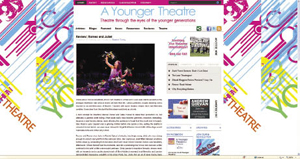
The first thing that is changing is change. Keeping up has to be a concern. Picking winners is even scarier. Is Second Life really the place for your virtual performances? Are Bebo and MySpace still central to your current social media strategies or are they passé? Are you confident that the current fashionable products are here to stay? What software will dominate the group purchasing market next? How do we handle the speed and variety of change in our over-stretched and already committed PR departments?
AUDIENCE FIRST
Not much has changed with respect to the public we try to reach. First and foremost we have to consider our audiences. But most arts organisations are aware that we cannot dispense with or reduce our traditional media activities. After the show or exhibition we want coverage from reporters and critics. Listings, previews and features are important before an event. For most of us, projecting our image beyond our audiences is a central consideration. Recognition and status with governments (local and national); sponsors and potential sponsors; peers and contemporaries are all of significance. But the digital world impinges on the ways we manage relationships.
Audiences have always used their right to reply. They have written to the press, given interviews, participated in focus groups and contacted us directly. With digital technologies, responses can be more immediate and involve less effort. And they can now be more effective as initiators. Social technologies allow them to add momentum to their opinions and ideas. Although they may simply send an email, they are increasingly likely to post on Facebook, where others can add comments or ‘like’. Activists can go further. Campaigns can be mounted, groups rapidly formed. Those with the inclination and the aptitude can establish themselves as influential bloggers or tweeters. And they can do this instantly from any location – from inside arts venues during the performance or when a comment occurs to them at some remote location. Not only do they interact with us but they interact with each other.
VIRAL RESPONSE
For arts professionals this has upsides and downsides. At times it opens us to potentially embarrassing criticisms. At worst these may go viral. Of course we still have to interpret the significance of such messages. They may be the views of an unrepresentative minority. They may be the predictable response to novelty or innovation. In any event, we should regard them as useful. Campaigns are more effectively initiated and facilitated when augmented by online channels. And the openness supported by digital technologies should be welcomed. It captures what should surely be an aspect of the spirit of the arts: co-creation and audience voices are to be valued.
All this leaves us on the horns of various dilemmas. We must maintain sets of existing relationships with our media contacts. Traditional techniques – press, radio, TV and other external relationships all remain important. But now our departments must contend with the multiple interactions of the digital world. And we must do this in a time of resource constraints. Do electronic technologies increase our productivity or do they inevitably require more and different resources or personnel? To what extent can we provision internally and to what extent can we contract out? Does the need to tweet, blog and provide content for Facebook necessarily add additional demands on our staffing? Or can we rely on our external supporters and commentators to supply the bulk of our content and advocate on our behalf? Whatever our reactions to these questions, it is apparent that we need to pursue and balance both traditional and new strategies and activities, as we negotiate an evolving press and PR scene.
Join the Discussion
You must be logged in to post a comment.